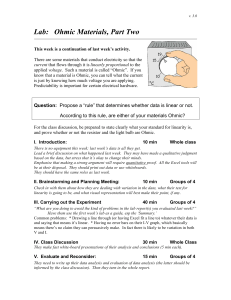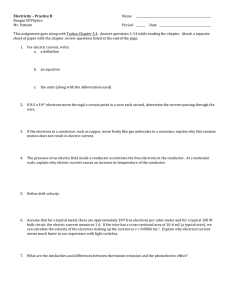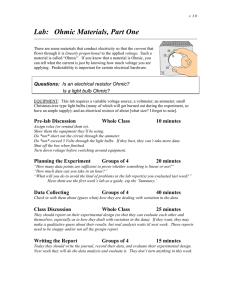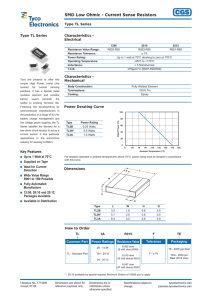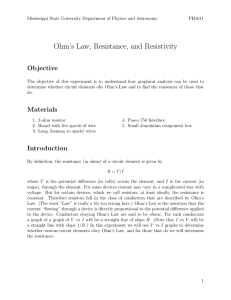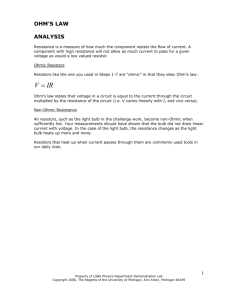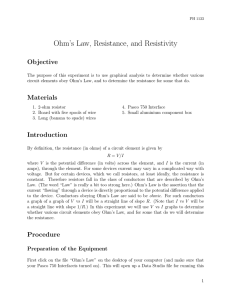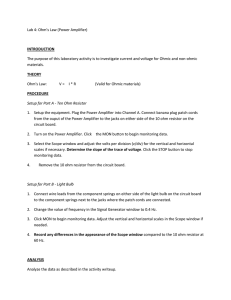Section 7: Ohmic Conductors and Ohm`s Law
advertisement
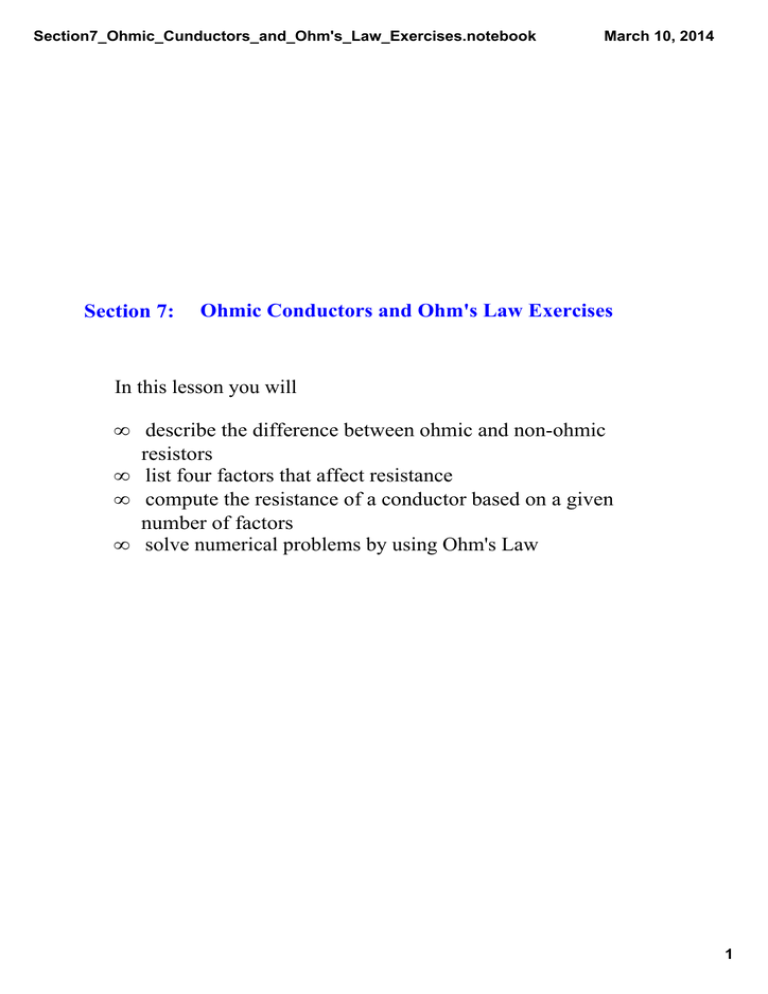
Section7_Ohmic_Cunductors_and_Ohm's_Law_Exercises.notebook Section 7: March 10, 2014 Ohmic Conductors and Ohm's Law Exercises In this lesson you will • describe the difference between ohmic and non­ohmic resistors • list four factors that affect resistance • compute the resistance of a conductor based on a given number of factors • solve numerical problems by using Ohm's Law 1 Section7_Ohmic_Cunductors_and_Ohm's_Law_Exercises.notebook March 10, 2014 Ohmic and non­ohmic resistors In section 6, we connected a small piece of toaster element to different voltages and measured the current through it. A graph of V versus I gave a straight line and the slope was defined as the resistance of the piece of toaster element. The piece of element is called a resistor, and the measure of its opposition to electron flow is called the resistance of the resistor. The resistance of any substance depends on the number of collisions of free electrons with the atoms or ions of the substance. (The greater the number of collisions, the greater the resistance.) When V versus I (or I versus V for that matter) results in a straight line, the resistor has a constant resistance. That is, the resistance does not change as the current through it increases. The graph remains straight. The slope is constant. Such resistors are said to be ohmic because they obey Ohm's law. 2 Section7_Ohmic_Cunductors_and_Ohm's_Law_Exercises.notebook March 10, 2014 Diagram 1: ­ 3 different ohmic resistors Diagram 2: ­ the resistor is ohmic for smaller currents and non­ohmic for larger currents. ­ As the current becomes larger, the circuit element heats up, which means its molecules vibrate faster. The extra vibration of the molecules makes it harder for electrons to pass through. That is, the resistance no longer remains constant. ­ As I becomes larger, the slope of the line steadily increases. ­ Not all non­ohmic resistors increase in resistance as the current increases, as show in diagram 3 and 4. Diagrams 3 and 4: ­ result from the same measurements. ­ The graphs only appear to be different because V and I are interchanged on the axes. ­ This graph is very similar to the characteristic graph of a diode. ­ As the current becomes larger, the slope becomes smaller. That is, the resistance becomes smaller, which in turn allows the current to flow more freely, and so on. Because the current increases so rapidly, the I versus V graph is usually the one that is shown in physics textbooks. Summing up: Ohmic means constant resistance, non­ohmic means the resistance is not constant. 3 Section7_Ohmic_Cunductors_and_Ohm's_Law_Exercises.notebook March 10, 2014 A resistor is a device that restricts the flow of electric current. By reducing the amount of current that can flow or ‘slowing it down’, you can make the electricity do work. When electrons pass through resistors, they collide with the molecules and lose some of their energy. This energy is transferred into other types of energy. Four Factors that Affect Resistance (i) Temperature: Resistance is increased with the increase of temperature and vice versa. (Not directly proportional) ­ As temperature increases the motion of the atoms and ions in the conductor increases, thus a greater chance that moving electrons will run into the atoms or ions. This increases the resistance. ­ In most cases, a non­ohmic substance increases in resistance as its temperature rises. (ii) Length: The resistance of a conductor is directly proportional to its length. ( R " L ) ­ As current is forced to move a longer distance, the probability of the electron colliding with an atom or ion increases, thus increasing its resistance. ­ In mathematical terms: R " L ­ Caution: in order to write that last expression the two resistors must be identical in every way except the length (same diameter, same substance, same temperature). or (iii) Cross­sectional Area: The resistance of a conductor is inversely proportional to its cross­ sectional area. ( R "1/A ) ­ A larger area means the electrons have more room to move around and thus less chance of a collision. Therefore, the resistance is decreased. ­ In mathematical terms: 4 Section7_Ohmic_Cunductors_and_Ohm's_Law_Exercises.notebook (iv) March 10, 2014 Nature of the material: The resistance of a conductor depends upon its atomic structure. ­ Silver and copper are extremely good conductors. Glass and hard rubber are non­conductors or insulators. It is not difficult to incorporate the type of material into a mathematical expression for resistance: where: R ­ is the resistance measured in ohms (S) D ­ is the resistivity of the substance (Sm) L ­ is the length of the material (m) A ­ is the cross­sectional area of the material (m2) ­ The physical name for ρ is resistivity. The resistivities of silver and copper are extremely tiny at 1.59 x 10­8 Ωm and 1.68 x 10­8 Ωm, respectively. On the other end of continuum, the resistivity of hard rubber is extremely large: 1013 to 1015 Ωm. From these values you can see that for a good conductor, ρ is very tiny; and for a good insulator ρ is very large. Examples: 1 Express the resistance of a wire in terms of the radius of the cross­section of the wire. 5 Section7_Ohmic_Cunductors_and_Ohm's_Law_Exercises.notebook 2 What is the resistance of a piece of aluminum wire, 1.5 km long with a diameter of 10.0 mm? The resistivity of aluminum is 1.86 x 10­8 Ω.m. 3 What is the resistivity of a piece of wire that is 1.8 m long, 1.2 mm in diameter, and having a total resistance of 0.027 Ω? 4 March 10, 2014 A piece of copper wire has a resistance of 2.0 x 10 ­ 3 S. What will be the resistance of another piece of copper wire with the same cross­sectional area but double the length? 6 Section7_Ohmic_Cunductors_and_Ohm's_Law_Exercises.notebook 5 March 10, 2014 A length of wire has a cross­sectional area of 3.0 mm2 and a resistance of 2.0 x 10 ­ 4 S. What will be the resistance of the same piece of wire that has the same length but whose cross­sectional area is 12 mm2? 7 Section7_Ohmic_Cunductors_and_Ohm's_Law_Exercises.notebook 6 March 10, 2014 Conductor A is 1.0 m long with a cross­sectional radius of 0.5 mm and a resistance of 2.0 Ω. Conductor B is made of the same material and is 4.0 m long and has a cross­sectional radius of 1.0 mm. What is the resistance of conductor B? 8 Section7_Ohmic_Cunductors_and_Ohm's_Law_Exercises.notebook 7 March 10, 2014 A resistor with specific dimensions has to be replaced! The same material is available but not in the same dimensions. The original resistor had a length of 20.0 cm and a circular diameter of 8 mm. The new resistor has a diameter of 5.0cm. What length would provide the same resistance? 9 Section7_Ohmic_Cunductors_and_Ohm's_Law_Exercises.notebook 8 March 10, 2014 A 150 m roll of copper wire has a resistance of 1.6 Ω. What will be the resistance of a 45 m length of wire cut from the roll? 10 Section7_Ohmic_Cunductors_and_Ohm's_Law_Exercises.notebook 9 March 10, 2014 Two wires are identical except that wire 1 has a cross­sectional area that is 3.5 times that of wire 2. If the resistance of wire 1 is 1.2 Ω, what is the resistance of wire 2? 11 Section7_Ohmic_Cunductors_and_Ohm's_Law_Exercises.notebook March 10, 2014 10 Two rolls of aluminum wire have respective lengths of 150 m and 85 m but identical resistances. The longer roll has a cross­sectional radius of 1.2 mm. What is the cross­sectional radius of the 85 m roll? Page 604: Questions 2 and 3, Page 620 – 621: Questions 3, 7, 23 – 28 12 Section7_Ohmic_Cunductors_and_Ohm's_Law_Exercises.notebook March 10, 2014 11 A small flashlight bulb draws 250 mA in a flashlight that has two 1.5 V dry cells in series. What is the resistance of the bulb filament? 12 If your hairdryer draws a current of 11.5 A on a 120 V line, what is the resistance of the hair­dryer circuitry? Suppose that you take your hair dryer to Europe where the line voltage is 220 V. If you make the mistake of plugging it in, what current will it draw? 13

